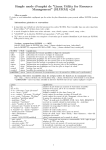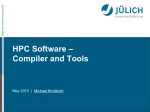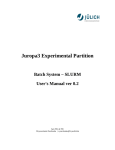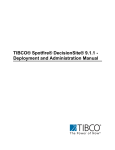Download Batch Usage in JSC - Introduction to Slurm
Transcript
Batch Usage in JSC Mitglied der Helmholtz-Gemeinschaft Introduction to Slurm May 2015 | Chrysovalantis Paschoulas | [email protected] Batch System Concepts (1) A cluster consists of a set of tightly connected "identical" computers that are presented as a single system and work together to solve computation-intensive problems. The nodes are connected through high speed local network and have access to shared resources like shared file-systems, etc. Batch Processing is the execution of programs or jobs without user's intervention. Mitglied der Helmholtz-Gemeinschaft A job is the execution of user-defined work-flows by the batch system. Resource Manager is the software responsible for managing the resources of a cluster, like tasks, nodes, CPUs, memory, network, etc. It manages also the execution of the jobs. It makes sure that jobs are not overlapping on the resources and handles also their I/O. Usually it is controlled by the scheduler. Batch System Concepts (2) Mitglied der Helmholtz-Gemeinschaft Scheduler/Workload-Manager is the software that controlls user's jobs on a cluster. It receives jobs from users and controls the resource manager to make sure that the jobs are completed successfully. Handles the job submissions and put jobs into queues. It offers many features like: ➔ user commands for managing the jobs (start, stop, hold) ➔ interfaces for defining work-flows and job dependencies ➔ interfaces for job monitoring and profiling (accounting) ➔ partitions and queues to control jobs according to policies and limits ➔ scheduling mechanisms, like backfilling according to priorities Batch System is the combination of a scheduler and a resource manager. It combines all the features of these two parts in an efficient way. Slurm for example offers both functionalities: scheduling and resource management. JSC Batch Model Job scheduling according to priorities. The jobs with the highest priorities will be scheduled next. Backfilling scheduling algorithm. The scheduler checks the queue and may schedule jobs with lower priorities that can fit in the gap created by freeing resources for the next highest priority jobs. No node-sharing. The smallest allocation for jobs is one compute node. Running jobs do not disturb each other. For each project a Linux group is created where the users belong to. Each user has available contingent from one project only*. Mitglied der Helmholtz-Gemeinschaft CPU-Quota modes: monthly and fixed. The projects are charged on a monthly base or get a fixed amount until it is completely used. Accounted CPU-Quotas per job = Number-of-nodes x Walltime Contingent/CPU-Quota states for the projects: normal, low-contingent, nocontingent. Contingent priorities: normal > lowcont > nocont. Users without contingent get some penalties for the their jobs, but they are still allowed to submit and run jobs. Slurm Introduction (1) Slurm is the chosen Batch System that will be used on JURECA. Slurm is an open-source project developed by SchedMD. For our clusters psslurm, which is a plug-in of psid daemon and part of the Parastation Cluster tools, will replace slurmd on the compute nodes. psslurm is under development by ParTec and JSC in the context of our collaboration. Slurm's configuration in JSC: ➔ High-availability for the main daemons slurmctld and slurmdbd. ➔ Backfilling scheduling algorithm. ➔ No node-sharing. ➔ Job scheduling according to priorities. Mitglied der Helmholtz-Gemeinschaft ➔ Accounting mechanism: slurmdbd with MySQL/MariaDB database as back-end storage ➔ User and job limits configured by QoS and Partitions. ➔ No preemption configured. Running jobs cannot be preempted. ➔ Prologue and Epilogue, with pshealthcheck from Parastation. Slurm Introduction (2) Slurm groups the compute nodes into Partitions (similar to queues from Moab). Some limits and policies can be configured for each Partition: ➔ allowed users, groups or accounts ➔ max. nodes and max. wall-time limit per job ➔ max. submitted/queued jobs per user Other limits are enforced also by the Quality-of-Services (QoS), according to the contingent of user's group, e.g. the maximum wall-time limit. Default limits/settings are used when not given by the users, like: number of nodes, number of tasks per node, wall-time limit, etc. According to group's contingent user jobs are given certain QoS: normal: group has contingent, high job priorities. Mitglied der Helmholtz-Gemeinschaft lowcont: this months contingent was used. penalty -> lower job priorities nocont: all contingent of the 3 months time-frame was used. penalty -> lowest job priorities and lower max. wall-time limit nolimits: special QoS for the admins (testing or maintenance) suspended: the group's project has ended; user cannot submit jobs Mitglied der Helmholtz-Gemeinschaft Slurm Architecture JUROPATEST JUROPATEST is a test system which allows users of JSC's current general purpose supercomputer JUROPA to port and optimize their applications for the new Haswell CPU architecture. Partitions: batch: default partition, includes all compute nodes Limits: max. 6h, default 30mins; max. 16 nodes, default 1 node large: all compute nodes, intended for large jobs Limits: max. 1h; default 30mins; max. 62 nodes; default 17 nodes maint: all compute nodes, used by the admins Mitglied der Helmholtz-Gemeinschaft For both batch and large partitions: ➔ max. 4 running jobs ➔ max. 20 pending/queued jobs System Usage – Modules The installed software of the clusters is organized through a hierarchy of modules. Loading a module adapts your environment variables to give you access to a specific set of software and its dependencies. Preparing the module environment includes two steps: 1. Load one of the available tool-chains. There are 3 levels of tool-chains: a) Compilers, b) Compilers+MPI and c) FullToolchains. 2. Then load other application modules, which where built with currently loaded tool-chain. Useful commands: List available toolchains Mitglied der Helmholtz-Gemeinschaft Load a toolchain $ module avail $ module load intelpara/2014.11 List all loaded modules $ module list List available modules $ module avail Check a package Load a module Unload a module Unload all loaded modules $ module spider Boost/1.56.0 $ module load Boost/1.56.0 $ module unload Boost/1.56.0 $ module purge System Usage – Compilation On our clusters in JSC, we offer some wrappers to the users, in order to compile and execute parallel jobs using MPI. The current wrappers are: mpicc, mpicxx, mpif77, mpif90 Some useful compiler options that are commonly used: g Enables debugging. openmp Enables the use of OpenMP. O[03] Sets the optimization level. L A path can be given to the linker for searching libraries. D Defines a macro. U Undefines a macro. Mitglied der Helmholtz-Gemeinschaft I Adds further directories to the include file search path. Compile an MPI program in C++: mpicxx O2 o mpi_prog program.cpp Compile a hybrid MPI/OpenMP program in C: mpicc openmp o mpi_prog program.c Slurm – User Commands (1) salloc is used to request interactive jobs/allocations. sattach is used to attach standard input, output, and error plus signal capabilities to a currently running job or job step. sbatch is used to submit a batch script (which can be a bash, Perl or Python script). scancel is used to cancel a pending or running job or job step. sbcast is used to transfer a file to all nodes allocated for a job. sgather is used to transfer a file from all allocated nodes to the currently active job. This command can be used only inside a job script. Mitglied der Helmholtz-Gemeinschaft scontrol provides also some functionality for the users to manage jobs or query and get some information about the system configuration. sinfo is used to retrieve information about the partitions, reservations and node states. smap graphically shows the state of the partitions and nodes using a curses interface. We recommend llview as an alternative which is supported on all JSC machines. Slurm – User Commands (2) sprio can be used to query job priorities. squeue allows to query the list of pending and running jobs. srun is used to initiate job-steps mainly within a job or start an interactive jobs. A job can contain multiple job steps executing sequentially or in parallel on independent or shared nodes within the job's node allocation. sshare is used to retrieve fair-share information for each user. sstat allows to query status information about a running job. sview is a graphical user interface to get state information for jobs, Mitglied der Helmholtz-Gemeinschaft partitions, and nodes. sacct is used to retrieve accounting information about jobs and job steps in Slurm's database. allows also the users to query some information about their accounts and other accounting information in Slurm's database. sacctmgr * For more detailed info please check the online documentation and the man pages. Slurm – Job Submission There are 2 commands for job allocation: sbatch is used for batch jobs and salloc is used to allocate resource for interactive jobs. The format of these commands: sbatch [options] jobscript [args...] salloc [options] [<command> [command args]] List of the most important submission/allocation options: c|cpuspertask Number of logical CPUs (hardware threads) per task. e|error Path to the job's standard error. i|input Connect the jobscript’s standard input directly to a file. J|jobname Set the name of the job. mailuser Define the mail address for notifications. mailtype When to send mail notifications. Options: BEGIN, END, FAIL, ALL Mitglied der Helmholtz-Gemeinschaft N|nodes Number of compute nodes used by the job. n|ntasks Number of tasks (MPI processes). ntaskspernode Number of tasks per compute node. o|output Path to the job's standard output. p|partition Partition to be used from the job. t|time Maximum wallclock time of the job. Slurm – Job Submission Examples Submit a job requesting 2 nodes for 1 hour, with 28 tasks per node (implied value of ntasks: 56): sbatch N2 ntaskspernode=28 time=1:00:00 jobscript Submit a job array of 4 jobs with 1 node per job, with the default wall-time: sbatch array=03 N1 jobscript Submit a job-script in the large partition requesting 62 nodes for 2 hours: sbatch N62 p large t 2:00:00 jobscript Submit a job requesting all available mail notifications to the specified email address: sbatch N2 mail[email protected] mailtype=ALL jobscript Mitglied der Helmholtz-Gemeinschaft Specify a job name and the standard output/error files: sbatch N1 J myjob o MyJob%j.out e MyJob%j.err jobscript Allocate 4 nodes for 1 hour: salloc N4 time=60 Slurm – Spawning Command With srun the users can spawn any kind of application, process or task inside a job allocation. srun should be used either: 1. Inside a job script submitted by sbatch (starts a job-step). 2. After calling salloc (execute programs interactively). Command format: srun [options...] executable [args...] Some useful options: forwardx Enable X11 forwarding only for interactive jobs. Mitglied der Helmholtz-Gemeinschaft pty Execute a task in pseudo terminal mode. multiprog <file> Run different programs with different arguments for each task specified in a text file. Note: In order to spawn the MPI applications, the users should always use srun and not mpiexec. Job-Script – Serial Job Instead of passing options to sbatch from the command-line, it is better to specify these options using the “#SBATCH” directives inside the job scripts. Mitglied der Helmholtz-Gemeinschaft Here is a simple example where some system commands are executed inside the job script. This job will have the name “TestJob”. One compute node will be allocated for 30 minutes. Output will be written in the defined files. The job will run in the default partition batch. #!/bin/bash #SBATCH J TestJob #SBATCH N 1 #SBATCH o TestJob%j.out #SBATCH e TestJob%j.err #SBATCH time=30 sleep 5 hostname Job-Script – Parallel Job Mitglied der Helmholtz-Gemeinschaft Here is a simple example of a job script where we allocate 4 compute nodes for 1 hour. Inside the job script, with the srun command we request to execute on 2 nodes with 1 process per node the system command hostname, requesting a walltime of 10 minutes. In order to start a parallel job, users have to use the srun command that will spawn processes on the allocated compute nodes of the job. #!/bin/bash #SBATCH J TestJob #SBATCH N 4 #SBATCH o TestJob%j.out #SBATCH e TestJob%j.err #SBATCH time=60 srun ntaskspernode=1 hostname Job-Script – OpenMP Job Mitglied der Helmholtz-Gemeinschaft In this example the job will execute an OpenMP application named “omp-prog”. The allocation is for 1 node and by default, since there is no node-sharing, all CPUs of the node are available for the application. The output filenames are also defined and a walltime of 2 hours is requested. Note: It is important to define and export the variable OMP_NUM_THREADS that will be used by the executable. #!/bin/bash #SBATCH J TestOMP #SBATCH N 1 #SBATCH o TestOMP%j.out #SBATCH e TestOMP%j.err #SBATCH time= 02:00:00 export OMP_NUM_THREADS=56 /home/user/test/ompprog Job-Script – MPI Job In the following example, an MPI application will start 112 tasks on 4 nodes running 28 tasks per node requesting a wall-time limit of 15 minutes in batch partition. Each MPI task will run on a separate core of the CPU. Mitglied der Helmholtz-Gemeinschaft #!/bin/bash #SBATCH nodes=4 #SBATCH ntasks=112 #SBATCH output=mpiout.%j #SBATCH error=mpierr.%j #SBATCH time=00:15:00 #SBATCH partition=batch srun N4 ntaskspernode=28 ./mpiprog Job-Script – Hybrid Job Mitglied der Helmholtz-Gemeinschaft In this example, a hybrid MPI/OpenMP job is presented. This job will allocate 5 compute nodes for 2 hours. The job will have 35 MPI tasks in total, 7 tasks per node and 4 OpenMP threads per task. On each node 28 cores will be used (no SMT enabled). Note: It is important to define the environment variable “OMP_NUM_THREADS” and this must match with the value of the option “cpuspertask/c”. #!/bin/bash #SBATCH J TestJob #SBATCH N 5 #SBATCH o TestJob%j.out #SBATCH e TestJob%j.err #SBATCH time= 02:00:00 #SBATCH partition=large export OMP_NUM_THREADS=4 srun N 5 ntaskspernode=7 cpuspertask=4 ./hybridprog Job-Script – Hybrid Job with SMT The CPUs on our clusters support Simultaneous Multi-Threading(SMT). SMT is enabled by default for Slurm. In order to use SMT, the users must either allocate more than half of the Logical Cores on each Socket or by setting some specific CPU-Binding(Affinity) options. This example presents a hybrid application which will execute “hybrid-prog” on 3 nodes using 2 MPI tasks per node and 28 OpenMP threads per task (56 CPUs per node). * Job was executed on JUROPATEST with 28 Logical Cores per Socket. Mitglied der Helmholtz-Gemeinschaft #!/bin/bash #SBATCH ntasks=6 #SBATCH ntaskspernode=2 #SBATCH cpuspertask=28 #SBATCH output=mpiout.%j #SBATCH error=mpierr.%j #SBATCH time=00:20:00 #SBATCH partition=batch export OMP_NUM_THREADS=${SLURM_CPUS_PER_TASK} srun ./hybridprog Job-Script – Multiple Job-Steps Slurm introduces the concept of job-steps. A job-step can be viewed as a smaller job or allocation inside the current allocation. Job-steps can be started only with the srun command. The following example shows the usage of job-steps. With sbatch we allocate 32 compute nodes for 6 hours. Then we spawn 2 job-steps. The first step will run on 16 compute nodes for 50 minutes, the second step on 2 nodes for 10 minutes and the third step will use all 32 allocated nodes for 5 hours. Mitglied der Helmholtz-Gemeinschaft #!/bin/bash #SBATCH N 32 #SBATCH time=06:00:00 #SBATCH partition=batch srun N 16 n 32 t 00:50:00 ./mpiprog1 srun N 2 n 4 t 00:10:00 ./mpiprog2 srun N 32 ntaskspernode=2 t 05:00:00 ./mpiprog3 Job Dependencies & Job-Chains Slurm supports dependency chains which are collections of batch jobs with defined dependencies. Job dependencies can be defined using the “dependency” or “d” option of sbatch. The format is: sbatch d <type>:<jobID> <jobscript> Available dependency types: after, afterany, afternotok, afterok Below is an example of a bash script for starting a chain of jobs. The script submits a chain of “$NO_OF_JOBS”. Each job will start only after successful completion of its predecessor. #!/bin/bash NO_OF_JOBS=<noofjobs> JOB_SCRIPT=<jobscriptname> Mitglied der Helmholtz-Gemeinschaft JOBID=$(sbatch ${JOB_SCRIPT} 2>&1 | awk '{print $(NF)}') I=0 while [ ${I} le ${NO_OF_JOBS} ]; do JOBID=$(sbatch d afterok:${JOBID} ${JOB_SCRIPT} 2>&1 | awk '{print $(NF)}') let I=${I}+1 done Job Arrays Slurm supports job-arrays which can be defined using the option “ a” or “array” of sbatch command. To address a job-array, Slurm provides a base array ID and an array index for each job. The format for specifying an array-job is: <base job id>_<array index> Slurm exports also 2 env. variables that can be used in the job scripts: SLURM_ARRAY_JOB_ID : base array job ID SLURM_ARRAY_TASK_ID : array index Mitglied der Helmholtz-Gemeinschaft Some additional options are available to specify the std-in/-out/-err file names in the job scripts: “%A” will be replaced by SLURM_ARRAY_JOB_ID and “%a” will be replaced by SLURM_ARRAY_TASK_ID. #!/bin/bash #SBATCH nodes=1 #SBATCH output=prog%A_%a.out #SBATCH error=prog%A_%a.err #SBATCH time=02:00:00 #SBATCH array=120 srun N 1 ntaskspernode=1 ./prog input_${SLURM_ARRAY_TASK_ID}.txt Interactive Jobs Interactive sessions can be allocated using the salloc command. The following command will allocate 2 nodes for 30 minutes: salloc nodes=2 t 00:30:00 After a successful allocation, salloc will start a shell on the login node where the submission happened. After the allocation the users can execute srun in order to spawn interactively their applications on the compute nodes. For example: srun N 4 ntaskspernode=2 t 00:10:00 c 7 ./mpiprog Mitglied der Helmholtz-Gemeinschaft The interactive session is terminated by exiting the shell. It is possible to obtain a remote shell on the compute nodes, after salloc, by running srun with the pseudo-terminal “pty” option and a shell as argument: srun cpu_bind=none N 2 pty /bin/bash It is also possible to start an interactive job and get a remote shell on the compute nodes with srun (not recommended without salloc): srun cpu_bind=none N 1 n 1 t 01:00:00 pty /bin/bash i Further Information Updated status of the systems: See „Message of today“ at login. Get recent status updates by subscribing to the system high-messages: http://juelich.de/jsc/CompServ/services/high_msg.html JUROPA online documentation: http://www.fz-juelich.de/ias/jsc/juropa JUROPATEST online documentation: http://www.fz-juelich.de/ias/jsc/juropatest JUROPATEST - Slurm User Manual (pdf): Mitglied der Helmholtz-Gemeinschaft http://fz-juelich.de/ias/jsc/juropatest-batchpdf JURECA online documentation: http://www.fz-juelich.de/ias/jsc/jureca User support at FZJ: Email: [email protected] Phone: +49 2461 61-2828 Mitglied der Helmholtz-Gemeinschaft Questions?
















































